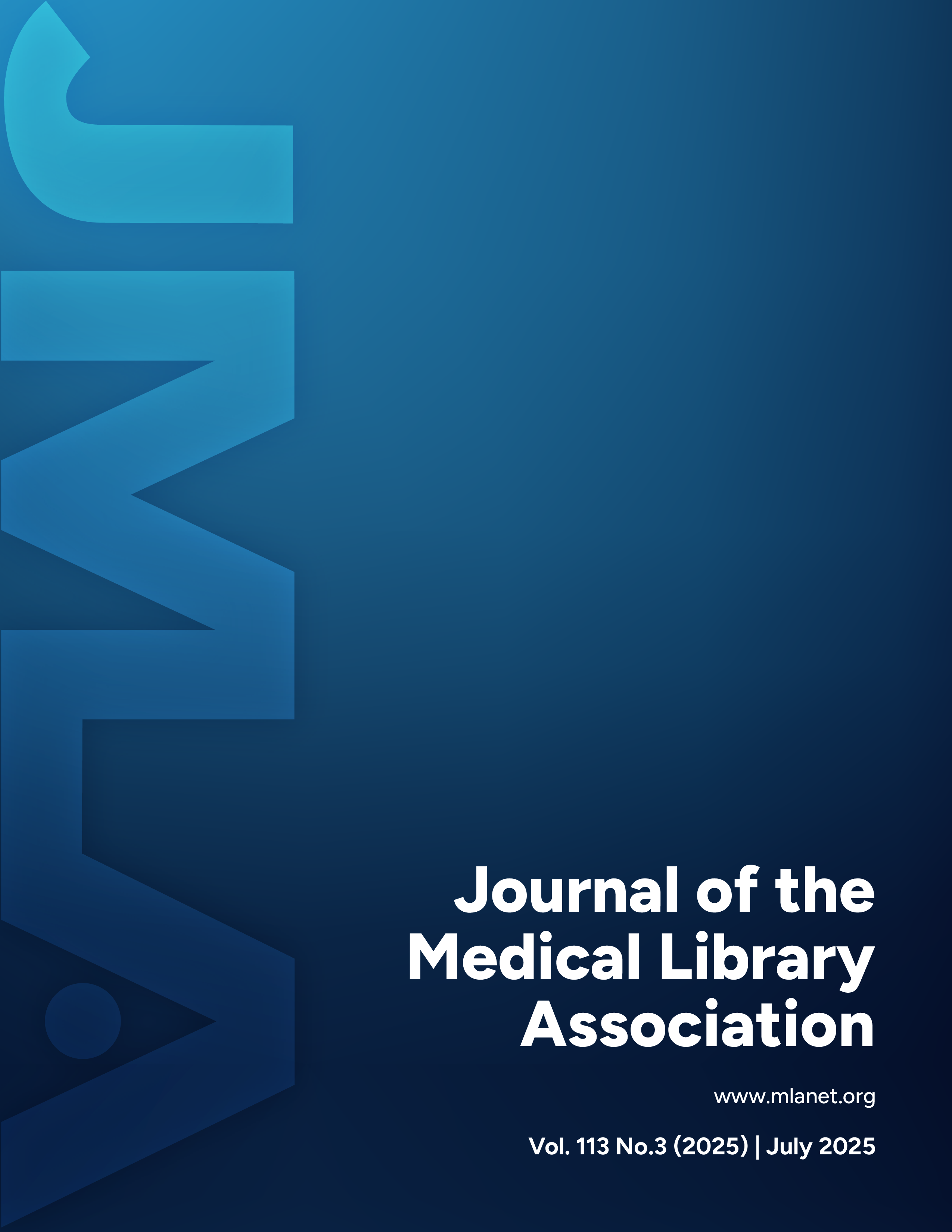Systematic librarian-led zip code analysis to target underserved communities
DOI:
https://doi.org/10.5195/jmla.2025.2053Keywords:
health literacy, outreach, consumer library, hospital librarianship, Social determinants of health, HospitalAbstract
Background: To compare the library’s health information service usage area and customer topics with the hospital’s reasons for hospitalizations to examine commonalities and explore potential growth opportunities within the community.
Case Presentation: Researchers partnered with the hospital for this project. IRB approval was received. Researchers gathered the health information service’s 2022 data, which was de-identified. Data analyzed included zip code and customer topics, which were coded according to the hospital’s business line, which was defined as why a patient was hospitalized or used the ED. The health information service’s business lines were compared with the hospital’s business lines. Lastly, researchers also reviewed the hospital’s targeted zip codes to see if those overlapped with the top zip codes that utilize the health information service. The top zip codes that used the library’s health information service were 37920, 37918, 37917, 37919, and 37876. Usage of the health information service varied across zip codes and topics. The most requested topics for the health information service and reasons for hospitalizations/ED visits were General Medicine in three of the five zip codes. Based on the data’s results, librarians performed outreach to organizations in the targeted zip codes to increase visibility of the library’s services.
Conclusion: The reasons people requested health information from the library aligned with hospitalizations and ED visits in most of the zip codes. Providing further outreach to the hospital’s targeted zip codes will benefit both the hospital and the library by increasing usage of the health information service.
References
Fast facts on U.S. hospitals [Internet]. American Heart Association. January 2024. https://www.aha.org/statistics/fast-facts-us-hospitals.
McDermott KW, Roemer M. Most frequent principal diagnoses for inpatient stays in U.S. hospitals, 2018 [Internet]. Agency for Healthcare Research and Quality. July 2021. https://hcup-us.ahrq.gov/reports/statbriefs/sb277-Top-Reasons-Hospital-Stays-2018.jsp.
Emergency department visits [Internet]. National Center for Health Statistics. April 15, 2024. https://www.cdc.gov/nchs/fastats/emergency-department.htm.
Fox S. The social list of health information [Internet]. Pew Research Center. January 15, 2014. https://www.pewresearch.org/short-reads/2014/01/15/the-social-life-of-health-information/.
Leonard K. Evaluating patient education materials for grade level J Consum Health Internet. 2017 Mar;21(1): 87–94. DOI: https://doi.org/10.1080/15398285.2017.1280347.
Hudson H. The medical library: a hospital’s most underappreciated asset [Internet]. Accreditation & Quality Compliance Advisor. September 12, 2023. https://www.accreditationqualitycenter.com/articles/medical-library-hospital%E2%80%99s-most-underappreciated-asset#:~:text=A%20medical%20librarian%20might%20be,region%20among%20potential%20future%20patients.
Eberle M. Medical librarians support clinical research and improve the patient experience [Internet]. Massachusetts Library System. March 8, 2019. https://masslibsystem.org/blog/2019/03/08/medical-librarianship-supporting-clinical-research-and-improving-the-patient-experience.
DeRosa AP, Baltich Nelson B, Delgado D, Mages KC, Martin L, Stribling JC. Involvement of information professionals in patient- and family-centered care initiatives: a scoping review. J Med Libr Assoc. 2019;107(3):314-322. doi:10.5195/jmla.2019.652.
Naccarella L, Horwood J. Public libraries as health literate multi-purpose workspaces for improving health literacy. Health Promot J Austr. 2021;32 Suppl 1:29-32. doi:10.1002/hpja.437.
What is health literacy? [Internet]. Center for Disease Control. July 11, 2023. https://www.cdc.gov/healthliteracy/learn/index.html#:~:text=Personal%20health%20literacy%20is%20the,actions%20for%20themselves%20and%20others.
Philbin MM, Parker CM, Flaherty MG, Hirsch JS. Public Libraries: A Community-Level Resource to Advance Population Health. J Community Health. 2019;44(1):192-199. doi:10.1007/s10900-018-0547-4.
Vernon JA, Trujillo A, Rosenbaum S, DeBuono B. Low health literacy: implications for national health policy. Washington, DC: Department of Health Policy, School of Public Health and Health Services, The George Washington University. 2007. https://hsrc.himmelfarb.gwu.edu/sphhs_policy_facpubs/172/.
Linnan LA, Wildemuth BM, Gollop C, Hull P, Silbajoris C, Monnig R. Public librarians as a resource for promoting health: results from the Health for Everyone in Libraries Project (HELP) librarian survey. Health Promot Pract. 2004;5(2):182-190. doi:10.1177/1524839903258018.
Basic promotion guide [Internet]. American Library Association. December 19, 2011. https://www.ala.org/tools/programming/adams/adamsssn15.
University of Tennessee medical center [Internet]. American Hospital Directory. 2022. https://www.ahd.com/free_profile/440015/University_of_Tennessee_Medical_Center/Knoxville/Tennessee/.
Profiles of health in Tennessee: knox county [Internet]. The Sycamore Institute. 2020. https://www.sycamoreinstitutetn.org/wp-content/uploads/Knox-County-Health-Profile.pdf.
Coughlin SS, Vernon M, Hatzigeorgiou C, George V. Health Literacy, Social Determinants of Health, and Disease Prevention and Control. J Environ Health Sci. 2020;6(1):3061.
Grabeel KL, Moore JC. Confronting the opioid crisis with consumer health information: a look at East Tennessee. J Med Libr Assoc. 2021;109(1):120-125. doi:10.5195/jmla.2021.1015.
Petersen DW, Earl M, Watson C, Grabeel K. Influence of library relocation and marketing: examining zip codes and health disparities to serve consumers in East Tennessee. J Med Libr Assoc. 2020;108(4):625-630. doi:10.5195/jmla.2020.965.
Paterick TE, Patel N, Tajik AJ, Chandrasekaran K. Improving health outcomes through patient education and partnerships with patients. Proc (Bayl Univ Med Cent). 2017;30(1):112-113. doi:10.1080/08998280.2017.11929552.
Petersen DW, Earl M, Watson C, Grabeel K. Influence of library relocation and marketing: examining zip codes and health disparities to serve consumers in East Tennessee. J Med Libr Assoc. 2020;108(4):625-630. doi:10.5195/jmla.2020.965.
Lindsay JM, Partee RP, Oelschlegel S, Leonard K. Mapping the changed to a health information service. Journal of Electronic Resources in Medical Libraries. 2016;13(3):124-130. DOI: https://doi.org/10.1080/15424065.2016.1235477
Swift H. Patient health and wellness: what’s zip code got to do with it? [Internet]. Wolters Kluwer. 2021. https://www.wolterskluwer.com/en/expert-insights/whats-zip-code-got-to-do-with-it.
Grabeel KL, Luhrs J, Roberts RE, Earl M. How One Library's Health Information Center Expanded Its Marketing Plan. Med Ref Serv Q. 2019;38(3):218-227. doi:10.1080/02763869.2019.1623612.
Elrod JK, Fortenberry JL Jr. Advertising in health and medicine: using mass media to communicate with patients. BMC Health Serv Res. 2020;20(Suppl 1):818. Published 2020 Sep 15. doi:10.1186/s12913-020-05599-3.
Gluckman J, Michaelis T. Measuring marketing effectiveness. Health Prog. 1987;68(7):47-50.
Downloads
Published
Issue
Section
License
Copyright (c) 2025 Rachel Roberts, Kelsey L. Grabeel

This work is licensed under a Creative Commons Attribution 4.0 International License.






